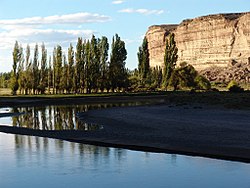This article needs additional citations for verification. (May 2011) |
| Chubut River | |
|---|---|
 A valley at Chubut River | |
 Map of the Chubut drainage basin | |
| Location | |
| Country | Argentina |
| Province | Chubut Province |
| Physical characteristics | |
| Mouth | |
• coordinates | 43°20′32″S 65°03′18″W / 43.34233217025459°S 65.05502613544668°W |
The Chubut River (Spanish: Río Chubut, Welsh: Afon Camwy) is located in the Patagonia region of southern Argentina. Its name comes from the Tehuelche word chupat, which means "transparent". The Argentine Chubut Province, through which the river flows, is named after it. Welsh settlers called the river "Afon Camwy", meaning "twisting river".
The river is generally shallow and its water flow can vary from 4 to 400 cubic metres per second (140 to 14,130 cu ft/s) between drought and flood. Average discharge is about 60 cubic metres per second (2,100 cu ft/s).[citation needed]
Flooding made the lands beside the river fertile and important for agriculture. The river has great importance for the agricultural and general economy of the province. There were several attempts to create dams near the two townships of Rawson and Gaiman. The Chubut River has a very rare characteristic being higher than the land around it which is mostly arid. Wheat farming was the chief crop and mainstay of the agricultural and commercial resources of Patagonia. At this time the settlers were struggling with finance as they were using sterling, which was in very short supply.
Wheat and barley became a more readily available material to trade with. The control of water for irrigation became even more important to newly arriving settlers who were allocated parcels of land or "chacras" issued by the Argentine government in the lower part of the valley. In 1882, following a very bad harvest in 1881, a scheme of irrigation ditches from a new canal would ensure consistent watering of crops and deal with the vagaries of the flow of the Chubut. This was key to the survival of the whole Chubut valley.
The construction of the canal and irrigation system was overseen by a young Welshman, E. J. Williams. His meticulous planning created a detailed system of ditches and channels according to an agreed size and fee structure with the settlers. These landowners dug the channels themselves with simple tools.[1]
The river is also a popular trout fishing destination.
- ^ Skinner, Kenneth (1984). Railway in the Desert (1 ed.). National Library of Wales, Aberystwyth: Beechen Green Books. pp. 40–41. ISBN 0-9509957-0-3.
